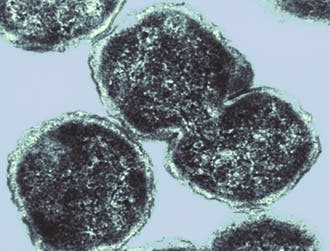When certain soil bacteria are forced to breed without oxygen, they start consuming nitrous oxide, a potent greenhouse gas. The discovery could enable a novel global warming mitigation method where bacteria sinks remove nitrous oxide from the atmosphere.

Nitrous oxide (N2O) is colorless and odorless. Also commonly called ‘laughing gas’, nitrous oxide is often used as a sedative because it relaxes patients thanks to its short-lasting euphoric effects. But as far as the climate is concerned, nitrous oxide is no laughing matter.
Scientists estimate that nitrous oxide accounts for about 10% of all greenhouse gases humans emit. However, the gas is 300 times more potent at trapping heat than carbon dioxide and can stay in the atmosphere for up to 120 years before it decomposes. And, unlike other greenhouse gases, nitrous oxide contributes to the depletion of the ozone layer with similar potency to the dreaded chlorofluorocarbons (CFCs) that are banned internationally.
Nitrous oxide is emitted during agricultural and industrial activities, as well as during combustion of fossil fuels and solid waste. According to a 2014 study, emissions of the ozone-depleting gas could double by the end of the century, if left unchecked.
Bearing all of this in mind, it is imperative that policymakers and the industry double down on efforts to curb greenhouse emissions while also implementing measures that remove the gas from the atmosphere. This may be where an intriguing new study might come in handy.

Bacteria release nitrous oxide naturally by breaking down nitrogen in the soil and oceans. However, researchers at the University of East Anglia (UEA) and the Norwegian University of Life Sciences have found that soil bacteria called Paracoccus denitrificans actually remove the gas.
“The main challenge we encountered was the ability to ‘tag’ the system for nitrous oxide production/destruction so that we could ‘see’ it by microscopy and ‘follow’ it within new bacteria in the laboratory without changing the natural activity of the cells. This is not always possible and important systems can be inactivated by the ‘tagging’ process, so we were lucky to find a way,” Andrew Gates, a lecturer in Bacterial Bioenergetics at the University of East Anglia and co-author of the new study, told ZME Science.
Experiments showed that the microorganism only breaks down N2O when its environment is devoid of oxygen. Researchers found that the bacteria has a clever ‘backup system’ in place which bets on nitrous oxide being present in its environment to give it a fighting chance in low-oxygen levels found in the soil. This system for nitrogen oxide destruction is kept active and proliferates among new cells.
“Our soils, water and the air we breathe are inextricably linked. Many agricultural soils are rich in bacteria that can destroy nitrous oxide. The goal is to identify conditions in which the rate of destruction is faster than the rate of production. Gradually we are building a better understanding of nitrous oxide destruction that may enable large-scale translation of laboratory studies like ours into soils through working with soil scientists,” Gates said.
The Paracoccus genus is quite versatile, with a wide range of diverse degradative capabilities and potential applications in bioremediation. For instance, strains have been isolated that utilize thiocyanate as an energy source, for the possible bioremediation of thiocyanate-contaminated wastewater from coke-oven factories. P. denitrificans can also grow under 400,000 times Earth’s gravity.
“We need to better define the scope of ‘bet hedging’ and priming of bacteria for nitrous oxide destruction in the environment. If we can understand the genetic regulation of this natural phenomenon – and how the active components for nitrous oxide destruction are moved to new cells during cell division – we can learn how to promote it where necessary and harness it as a new biotechnology in the future,” Gates concluded.
The findings appeared in the journal Proceedings of the National Academy of Sciences.


